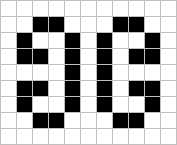Clips
Clips (also called inducting docks with curls, or 30-great sym) is a 30-bit still life consisting of two mutually-stabilizing docks with curls.
| Clips | |||
| |||
| View static image | |||
| Pattern type | Strict still life | ||
|---|---|---|---|
| Number of cells | 30 | ||
| Bounding box | 9×7 | ||
| Frequency class | 30.1 | ||
| Discovered by | Unknown | ||
| Year of discovery | Unknown | ||
| |||
| |||
| |||
| |||
Commonness
Clips is the 762nd most common still life and 800th most common object overall on Adam P. Goucher's Catagolue, being less common than integral with hook and beehive, but more common than house on down bun. It is also the most common 30-bit still life on Catagolue, being more common than cis-mirrored very very long bee siamese eaters.
gollark: I realized it might be easier to graph this, so... here you go?
gollark: Sure.
gollark: It says the biggest thing is at... index 0?
gollark: Now to extract frequencies.
gollark: Okay, I HAVE attained a Fourier transform of my data.
See also
This article is issued from Conwaylife. The text is licensed under Creative Commons - Attribution - Sharealike. Additional terms may apply for the media files.
